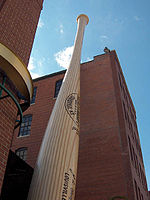Bloody Monday
1855 in Kentucky1855 riotsAnti-Catholic riots in the United StatesAnti-German sentiment in the United StatesAnti-Irish sentiment ... and 14 more
August 1855 eventsCrimes in Louisville, KentuckyGerman-American culture in Louisville, KentuckyHistory of Louisville, KentuckyIncidents of anti-Catholic violenceIrish-American culture in Louisville, KentuckyKnow NothingMassacres in the United StatesMassacres of CatholicsMondayPersecution by ChristiansProtestant–Catholic sectarian violenceReligiously motivated violence in the United StatesRiots and civil disorder in Kentucky

Bloody Monday was a series of riots on August 6, 1855, in Louisville, Kentucky, an election day, when Protestant mobs attacked Irish and German Catholic neighborhoods. These riots grew out of the bitter rivalry between the Democrats and the Nativist Know-Nothing Party. Multiple street fights raged, leaving twenty-two people dead, scores injured, and much property destroyed by fire. Five people were later indicted, but none were convicted, and the victims were not compensated.
Excerpt from the Wikipedia article Bloody Monday (License: CC BY-SA 3.0, Authors, Images).Bloody Monday
West Main Street, Louisville
Geographical coordinates (GPS) Address Nearby Places Show on map
Geographical coordinates (GPS)
| Latitude | Longitude |
|---|---|
| N 38.257777777778 ° | E -85.767222222222 ° |
Address
Marker Number 2205
West Main Street 1011
40202 Louisville
Kentucky, United States
Open on Google Maps







